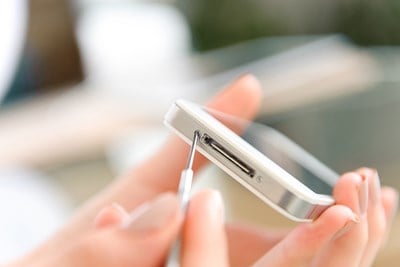When you’re shopping for a phone, it is important to remember there is more to your decision than how bright the screen and how pretty the pictures it takes. For something you carry with you everywhere, that costs as much as renting a small apartment for a month, you want to know that it can withstand its environment. Rainy day conversations, dropping it in the toilet, checking Facebook in a dust storm—whatever it may be, phones come with a rating to tell you just how resistant they are to the outside world. Here’s a look at what IP ratings mean when it comes to your cell phone.
What is an IP Rating?
Ingress Protection Ratings, also called International Protecting Ratings or IP Ratings. are the numbers that determine how well your phone prevents moisture and dust from entering its electrical components. The International Electrotechnical Commission (IEC) adopted it first and was quickly followed as the American National Standard, as well. More than how well the phone itself withstands hazards, the ANSI/IEC further describes the ratings as providing “a system for classifying the degrees of protection provided by enclosures of electrical equipment.” Essentially, an IP Rating is a rating system for how well the outside of your phone protects the inside of your phone.
Even more particularly, this rating system is for (a) “the protection of persons against access to hazardous parts and protection of equipment against the ingress of solid foreign objects” and (b) “the ingress of water”. This means the first rating number refers to how well your phone’s casing can keep you from touching internal parts because they could be dangerous and how well the casing can keep out solids that could be dangerous to your phone. These problematic items include intentional fingers, dust, inadvertent thumbs, etc. The second rating applies very specifically to how well your phone’s casing can keep out water—not liquids; not coffee or wine or cereal milk; only water.
What do IP Ratings mean for my cell phone?
Solid Particle (1st) Number
In order to really understand the full scope of IP Ratings, you have to realize they are not intended solely for use with cell phones—the system was created by an electrotechnical commission, not a smartphone-specific one. This, perhaps, can lend some clarity in regards to why your phone needs a rating for how well it keeps your fingers out of it. It may not need this type of rating, but electrical sockets do. You do, however, need to know how well a potential phone might keep out dust.
For the first number regarding the “ingress of solid foreign objects,” this classification measures how well dust is kept out. It works on a 0-6 scale. 0 means essentially absolutely anything and most especially dust can get inside, and 6 means that the designer will eat his hat if you find a single speck of dust inside this phone. Here’s a chart for specificity:
| Number | Protection Level | Explanation |
| 0 | (none) | No Protection |
| 1 | Anything Larger than 50 mm | — |
| 2 | Anything Larger than 12.5 mm | — |
| 3 | Anything Larger than 2.5 mm | — |
| 4 | Anything Larger than 1 mm | — |
| 5 | Dust Protected | Large Quantities of Dust Prevented |
| 6 | Dust Tight | Dust Entirely Prevented |
Liquid Ingress (2nd) Number
The second number runs from 0-9K. Zero provides no water resistance whatsoever, while 9 can mean that the product can sit in more than a meter of water given certain conditions (think of a watch—up to so many minutes) without causing significant harm to the device. It could also mean that the phone or electronic is hermetically sealed so water can’t enter. Here’s another chart for clarity:
| Number | Protection Level | Explanation |
| 0 | (none) | No Protection |
| 1 | Water Droplets | 1 mm of Rainfall a min |
| 2 | Dripping Water When Electronic Tilted | 3 mm of Rainfall a min |
| 3 | Sprayed Water | 5 min Spray |
| 4 | Water Splashes | 10 min of Spray |
| 5 | Water Jets | 12.5 liters/min for 3 min |
| 6 | Powerful Jets of Water | 100 liters/min for 3 min |
| 6K | High-Pressure Water Jets | 10x the Pressure of Level 6 |
| 7 | Immersion to 1 m | — |
| 8 | Immersion Over 1m | — |
| 9K | High-Pressure, High-Temp Water Jets | Water Temp of 176°F |
As an example, the numbers on your phone might read “IP00.” This means your phone is wide open to fingers, dust, water, and just about anything else that might want to get into it. Do not ever buy a phone with a double 0 IP rating (if you can even find one that exists). These numbers can continue all the way up to IP69K, which would mean not a speck of dust will ever get inside this phone, and you can steam clean it with power jets without any issues.
What are the IP Codes of the Two Most Popular Phones on the Market?
We're so glad you asked! The iPhone 7 and Samsung 8s, two of the newest, most popular smartphones, come with ratings of IP67 and IP68, respectively. Both of these are on the highest end of the solids scale, which means dust shouldn’t intrude into either. Unfortunately, you can’t steam clean them with a power washer. They are, however, water resistant to a significant degree. The iPhone 7 can be submerged in up to a meter of water for a few minutes, while the Samsung 8S can stand more than a meter of water. More simply, the iPhone can handle a quick dunk while the Samsung should withstand complete submersion, even with a little bit of pressure on top of it. However, given that they aren’t hermetically sealed, they aren’t guaranteed to spend an hour in the bottom of your shower without having a little bit of trouble. They can handle a few minutes of water without experiencing significant damage to the important parts. Unfortunately, most phones before these models have not been regularly given standardized testing IP ratings, although there are a plethora of homegrown YouTube videos from phone owners attempting to rate their cell phones that may give you an idea of how resistant to dust and water your phone is.



